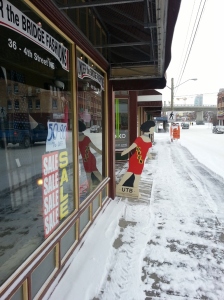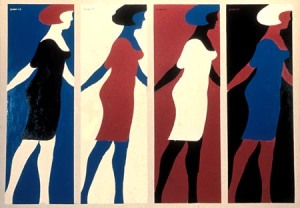
Advertising is an interesting field.
But before I get talking about advertising, I want to talk about “pop-art” first.
In the very near future we will be hearing much more about “pop-art” – not that we haven’t heard much before. That comment of course was somewhat tongue in cheek, as there was a recent sale (November 2014) of an Andy Warhol painting of Elvis Presley that sold for US $81.9-million.
Primarily why we will be hearing more about this is because Yale University Press will be releasing a long-anticipated book tomorrow (January 6, 2015) – Thomas Crow’s book The Long March of Pop: Art, Music and Design, 1930-1995. In this book, there will be some discussion surrounding the placement of pop art in relation to folk art and music – especially in the USA. There will be further discussion on pop-art outside of the USA as well, in places such as the UK which is a very important place for discussion surrounding this art historical term. I think this will be a very interesting discussion to have and hopefully expand the dialogue further.
There are currently two exhibitions of note, relating to “pop-art” that are currently on view elsewhere. I am sure that there are more than just two, however these two are located closest to Calgary, for those that are inclined to travel for business or personal pleasure.
- The Seattle Art Museum currently has an exhibition that talks about pop and its effect on artists that have produced or are currently working that takes pop art as a point of departure. It ends in little over a week from now.
- The Montreal Museum of Fine Arts (Musée des Beaux-Art de Montréal) currently has an exhibition of Andy Warhol`s advertising posters on view. As part of this exhibition two catalogue raisonnés have been produced – one dealing with Andy Warhol’s commissioned posters and the other his commissioned magazine work. I am sure that this would be a very interesting show to view as it probably covers a lot of ground that we don’t often see in a gallery exhibition. This show will continue until mid-March.
This last show of course leads me into advertising – which ties in well with “pop-art” as a general rule. For this reason why I believe that the MMFA/MBAM show mentioned above would be so interesting to see.
All businesses need to do some form of advertising if they want to stay in business. It is a fact of modern life.
Having owned a few businesses myself, I understand the necessity to advertise and create publicity for the business (having worked in corporate public relations beforehand, it was an easy sell). On the other side of the equation, I also understand the futility and frustration that comes with it as well.
It is a damned if you do, and damned if you don’t type of scenario.
This is primarily because measuring advertising effectiveness involves highly subjective criteria. It this way, partly because of how difficult it is to effectively evaluate, quantify and measure value; and measure the sales efficacy of the advertising dollar. In many ways spending money on advertising is always a bit of a crap shoot trying to determine what is going to work most successfully, because the ground is always shifting and what worked in the past does not always work in the future.
One of the oldest and most inexpensive forms of advertising is to simply place a sign outside of the business door – essentially to “hang out a shingle”.
Normally there is not much creativity exercised in these type of things. Outside of the main signage which is attached to the building or storefront, there is the possibility of a sandwich board, maybe some signage in the window, or some other variation on one or both of these themes. It is usually pretty straight-forward.
* * *
Yesterday, I walked past a piece of street advertising placed outside of a business door on Edmonton Trail.
I have passed this sign which is illustrated at the top of the post before. I suspect that it has been standing outside the door of this business for a number of years. How long? I have no idea, but it has been there as long as I can remember in recent memory.
Every time I see it, I think of Michael Snow and his Walking Woman series of paintings, drawings and sculptures dating from the 1960s and 1970s (although I believe he may have done some in the 1980s as well, but not as frequently). They are iconic pieces of Canadian art history – drawing from both conceptual and pop roots in Toronto.

The painting above is entitled Four, 1963. It was exhibited (and presumably sold) through Isaacs Gallery in Toronto during the 1960s. Its present location is unknown.
Michael Snow was definitely at the leading edge of artists at that time and has continued to produce work of significance since the 1950s. He is now in mid-80s and his importance is acknowledged by his being named a Companion of the Order of Canada.
I have previously mentioned Michael Snow in conjunction with the large Canada Geese sculpture/installation that he did for the atrium of Eaton Centre in Toronto. Anyone that has visited that building would certainly remember it.
He is one of our more important artists. One that we rarely see exhibited in Western Canada.
Even though it is a hunch on my part. It would seem to be a safe bet to assume that the maker or designer of this sign borrowed heavily from the central image of one of Michael Snow’s paintings or sculptures of a Walking Woman – whether they were aware of his work, or not. Notwithstanding this, the concept of seeing signage that is either unusual and/or creatively exercised is definitely appreciated in this city, as most other signage is generally safe and conservative.
For this sign, it is the idea that counts.



